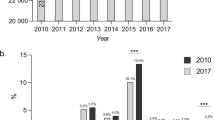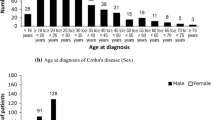Abstract
Purpose
Crohn’s disease (CD) is a chronic inflammatory bowel disease that requires surgery in many cases. The aim of this article is to present the experience of a referral center regarding surgical interventions for CD, while also exploring the transformations that have occurred over 10 years.
Methods
The data of patients underwent abdominal surgery for CD between 2013 and 2022 were collected prospectively. Data were compared between two periods (2013–2017 and 2018–2022). Temporal trends were assessed with the Mann–Kendall trend test.
Results
A total of 1059 individuals underwent 1176 surgical procedures, of which 67.1% were male. The median age of patients at the time of surgery was 36.0 years, and an overall increasing trend was observed in surgical volume (z = 3.04; p = 0.002). The proportion of patients treated with biologics increased from the first period (2013–2017) to the second (2018–2022), rising from 19.2% to 33.5% (p < 0.001). In the second stage, the proportion of patients who underwent surgery for abscesses or fistulas increased (47.8% vs. 40.0%, p = 0.028), while the percentage of emergency surgeries declined (3.0% vs. 7.1%, p = 0.001). Furthermore, there was a rise in the proportion of laparoscopic surgeries (76.5% vs. 63.7%, p < 0.001), coupled with a decrease in stoma rates (15.4% vs. 30.5%, p < 0.001) and postoperative complications (23.0% vs. 30.5%, p = 0.007).
Conclusion
The frequency of biologics use in CD surgery have increased over time, and the proportion of penetrating patients has grown. Minimally invasive surgical methods have become the norm, and surgical outcomes have markedly enhanced, evidenced by a substantial reduction in both stoma rates and complication rates.




Similar content being viewed by others
Data availability
Data supporting the findings of this study are available from the corresponding author on reasonable request.
References
Stoss C, Berlet M, Reischl S, Nitsche U, Weber MC, Friess H, Wilhelm D, Neumann PA (2021) Crohn’s disease: a population-based study of surgery in the age of biological therapy. Int J Colorectal Dis 36:2419–2426. https://doi.org/10.1007/s00384-021-03930-w
Ng SC, Shi HY, Hamidi N, Underwood FE, Tang W, Benchimol EI, Panaccione R, Ghosh S, Wu J, Chan F et al (2017) Worldwide incidence and prevalence of inflammatory bowel disease in the 21st century: a systematic review of population-based studies. Lancet 390:2769–2778. https://doi.org/10.1016/S0140-6736(17)32448-0
Ran Z, Wu K, Matsuoka K, Jeen YT, Wei SC, Ahuja V, Chen M, Hu PJ, Andoh A, Kim HJ et al (2021) Asian Organization for Crohn’s and Colitis and Asia Pacific Association of Gastroenterology practice recommendations for medical management and monitoring of inflammatory bowel disease in Asia. J Gastroenterol Hepatol 36:637–645. https://doi.org/10.1111/jgh.15185
Satsangi J, Silverberg MS, Vermeire S, Colombel JF (2006) The Montreal classification of inflammatory bowel disease: controversies, consensus, and implications. Gut 55:749–753. https://doi.org/10.1136/gut.2005.082909
Lui R, Ng SC (2016) The same intestinal inflammatory disease despite different genetic risk factors in the East and West? Inflamm Intest Dis 1:78–84. https://doi.org/10.1159/000446625
Geltzeiler CB, Hart KD, Lu KC, Deveney KE, Herzig DO, Tsikitis VL (2015) Trends in the surgical management of Crohn’s disease. J Gastrointest Surg 19:1862–1868. https://doi.org/10.1007/s11605-015-2911-3
Wu E, Duan M, Han J, Zhang H, Zhou Y, Cao L, Gong J, Guo Z, Li Y, Zhu W (2022) Patients with Crohn’s disease undergoing abdominal surgery: Clinical and prognostic evaluation based on a single-center cohort in China. World J Surg 46:450–460. https://doi.org/10.1007/s00268-021-06366-z
Moghadamyeghaneh Z, Carmichael JC, Mills SD, Pigazzi A, Stamos MJ (2015) Outcomes of bowel resection in patients with Crohn’s disease. Am Surg 81:1021–1027
Siassi M, Weiger A, Hohenberger W, Kessler H (2007) Changes in surgical therapy for Crohn’s disease over 33 years: a prospective longitudinal study. Int J Colorectal Dis 22:319–324. https://doi.org/10.1007/s00384-006-0150-5
Ng SC, Tang W, Ching JY, Wong M, Chow CM, Hui AJ, Wong TC, Leung VK, Tsang SW, Yu HH et al (2013) Incidence and phenotype of inflammatory bowel disease based on results from the Asia-pacific Crohn’s and colitis epidemiology study. Gastroenterology 145:158–165. https://doi.org/10.1053/j.gastro.2013.04.007
Khoudari G, Mansoor E, Click B, Alkhayyat M, Saleh MA, Sinh P, Katz J, Cooper GS, Regueiro M (2020) Rates of intestinal resection and colectomy in inflammatory bowel disease patients after initiation of biologics: A cohort study. Clin Gastroenterol Hepatol. https://doi.org/10.1016/j.cgh.2020.10.008
Dittrich AE, Sutton RT, Haynes K, Wang H, Fedorak RN, Kroeker KI (2020) Incidence rates for surgery in Crohn’s disease have decreased: A population-based time-trend analysis. Inflamm Bowel Dis 26:1909–1916. https://doi.org/10.1093/ibd/izz315
Yao LY, Shao BL, Tian F, Ye M, Li YQ, Wang XL, Wang L, Yang SQ, Lv XP, Jia Y et al (2022) Trends in medication use and treatment patterns in Chinese patients with inflammatory bowel disease. World J Gastroenterol 28:4102–4119. https://doi.org/10.3748/wjg.v28.i30.4102
Mandel MD, Miheller P, Mullner K, Golovics PA, Lakatos PL (2014) Have biologics changed the natural history of Crohn’s disease? Dig Dis 32:351–359. https://doi.org/10.1159/000358135
Mege D, Garrett K, Milsom J, Sonoda T, Michelassi F (2019) Changing trends in surgery for abdominal Crohn’s disease. Colorectal Dis 21:200–207. https://doi.org/10.1111/codi.14450
Bouhnik Y, Carbonnel F, Laharie D, Stefanescu C, Hebuterne X, Abitbol V, Nachury M, Brixi H, Bourreille A, Picon L et al (2018) Efficacy of adalimumab in patients with Crohn’s disease and symptomatic small bowel stricture: a multicentre, prospective, observational cohort (CREOLE) study. Gut 67:53–60. https://doi.org/10.1136/gutjnl-2016-312581
Celentano V, O’Leary DP, Caiazzo A, Flashman KG, Sagias F, Conti J, Senapati A, Khan J (2019) Longer small bowel segments are resected in emergency surgery for ileocaecal Crohn’s disease with a higher ileostomy and complication rate. Tech Coloproctol 23:1085–1091. https://doi.org/10.1007/s10151-019-02104-9
Mege D, Michelassi F (2020) Laparoscopy in Crohn disease: Learning curve and current practice. Ann Surg 271:317–324. https://doi.org/10.1097/SLA.0000000000002995
Ge X, Tang S, Yang X, Liu W, Ye L, Yu W, Xu H, Cao Q, Zhou W, Cai X (2019) The role of exclusive enteral nutrition in the preoperative optimization of laparoscopic surgery for patients with Crohn’s disease: A cohort study. Int J Surg 65:39–44. https://doi.org/10.1016/j.ijsu.2019.03.012
Alshantti A, Hind D, Hancock L, Brown SR (2021) The role of Kono-S anastomosis and mesenteric resection in reducing recurrence after surgery for Crohn’s disease: a systematic review. Colorectal Dis 23:7–17. https://doi.org/10.1111/codi.15136
Ma C, Almutairdi A, Tanyingoh D, Seow CH, Novak KL, Lu C, Panaccione R, Kaplan GG, Kotze PG (2019) Reduction in surgical stoma rates in Crohn’s disease: a population-based time trend analysis. Colorectal Dis 21:1279–1287. https://doi.org/10.1111/codi.14731
Author information
Authors and Affiliations
Contributions
Wei Liu and Wei Zhou developed the study concept and design. Xiaolong Ge, Weilin Qi, Zhaoqi Shi, Ziyao Wei and Qian Cao collected and analyzed the data. Wei Liu, Liping Cao and Wei Zhou wrote the manuscript. All authors reviewed the manuscript.
Corresponding author
Ethics declarations
Conflict of interest
The authors declare no competing interests.
Additional information
Publisher's Note
Springer Nature remains neutral with regard to jurisdictional claims in published maps and institutional affiliations.
Rights and permissions
Springer Nature or its licensor (e.g. a society or other partner) holds exclusive rights to this article under a publishing agreement with the author(s) or other rightsholder(s); author self-archiving of the accepted manuscript version of this article is solely governed by the terms of such publishing agreement and applicable law.
About this article
Cite this article
Liu, W., Ge, X., Shi, Z. et al. Temporal trends in surgery for Crohn’s disease: a ten-year single-center retrospective study. Int J Colorectal Dis 38, 221 (2023). https://doi.org/10.1007/s00384-023-04514-6
Accepted:
Published:
DOI: https://doi.org/10.1007/s00384-023-04514-6




